 (Image by Nan Yang Authentic)
In search of a better life, thousands of Chinese fled the turbulent Qing Dynasty (清朝) for Nanyang. In their heads were these sunny, idyllic, bountiful lands bursting with opportunities. Nonetheless, many, arrived penniless, wound up as coolies in the tin-mining industry, while some juggled with odd jobs at commercial hubs during the British Colonial era, living an equally harsh, if not worse, life.
Longing for home, these frugal wanderers adapted and incorporated local ingredients, such as the pandan leaf and the lemon grass, into their cooking, and re-created those familiar tastes based on memories; hence, the birth of Nanyang cuisine. Since a great number of them settled in Ipoh, a major tin-mining town then, many Nanyang delicacies were born there. Today, every mouthful of these humble and yet flavorful dishes sheds tears and the stories of these pioneers.
(Image by Nan Yang Authentic)
In search of a better life, thousands of Chinese fled the turbulent Qing Dynasty (清朝) for Nanyang. In their heads were these sunny, idyllic, bountiful lands bursting with opportunities. Nonetheless, many, arrived penniless, wound up as coolies in the tin-mining industry, while some juggled with odd jobs at commercial hubs during the British Colonial era, living an equally harsh, if not worse, life.
Longing for home, these frugal wanderers adapted and incorporated local ingredients, such as the pandan leaf and the lemon grass, into their cooking, and re-created those familiar tastes based on memories; hence, the birth of Nanyang cuisine. Since a great number of them settled in Ipoh, a major tin-mining town then, many Nanyang delicacies were born there. Today, every mouthful of these humble and yet flavorful dishes sheds tears and the stories of these pioneers.
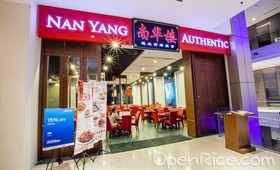
 (Image by Nan Yang Authentic)
“We strive to be a voice for our forefathers, mainly through showcasing their culinary creations,” said Mr. Hee, the person-in-charge for the new Nan Yang Authentic restaurant (南華樓) in the Pavilion, which opens daily between 10 a.m. and midnight.
(Image by Nan Yang Authentic)
“We strive to be a voice for our forefathers, mainly through showcasing their culinary creations,” said Mr. Hee, the person-in-charge for the new Nan Yang Authentic restaurant (南華樓) in the Pavilion, which opens daily between 10 a.m. and midnight.
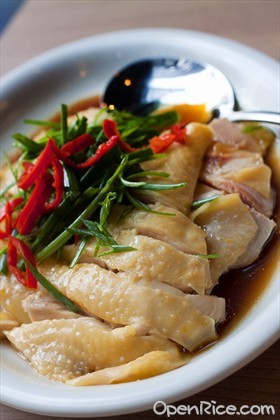 Introduced by Hainanese laborers in the late 19th century, White-Cut Chicken (白切雞) was enjoyed during the festive seasons. Fresh chicken is poached in a delicate, naturally flavored liquid base until cooked, then gets plunged in ice-cold water to halt the cooking and render the bird’s skin a handsome sheen and a smooth, springy texture. The meat is succulent and not greasy. Since it is about minimal seasoning, it is served with only grated garlic, scallion oil, and a simple dip made of light soy sauce, sesame oil, and a touch of house-made aromatic oil. So, the fresh sweetness of the chicken still shines through in every bite. The chef recommends organic, free-range chicken for best results, but normal chicken is available for those who prefer.
Introduced by Hainanese laborers in the late 19th century, White-Cut Chicken (白切雞) was enjoyed during the festive seasons. Fresh chicken is poached in a delicate, naturally flavored liquid base until cooked, then gets plunged in ice-cold water to halt the cooking and render the bird’s skin a handsome sheen and a smooth, springy texture. The meat is succulent and not greasy. Since it is about minimal seasoning, it is served with only grated garlic, scallion oil, and a simple dip made of light soy sauce, sesame oil, and a touch of house-made aromatic oil. So, the fresh sweetness of the chicken still shines through in every bite. The chef recommends organic, free-range chicken for best results, but normal chicken is available for those who prefer.
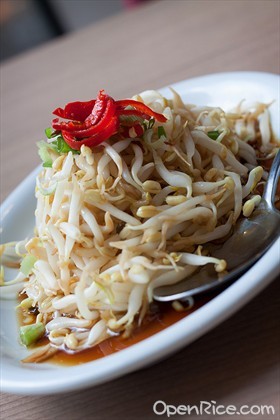 Pair White-Cut Chicken with short, plump, crunchy, juicy, sweet Ipoh-grown bean sprouts and you get the renowned Ipoh Taugeh Chicken (怡保芽菜雞). The bean sprout first reached Nanyang shores centuries ago with Chinese immigrants. Back then they were blanched to cook and served simply with scallion, ginger, and light soy sauce or salt. Today, they are “simmered” just until cooked and, to heighten the natural sweetness within, seasoned with light soy sauce, toasted sesame oil, oyster sauce, ginger, scallion, and thin strips of chile.
Pair White-Cut Chicken with short, plump, crunchy, juicy, sweet Ipoh-grown bean sprouts and you get the renowned Ipoh Taugeh Chicken (怡保芽菜雞). The bean sprout first reached Nanyang shores centuries ago with Chinese immigrants. Back then they were blanched to cook and served simply with scallion, ginger, and light soy sauce or salt. Today, they are “simmered” just until cooked and, to heighten the natural sweetness within, seasoned with light soy sauce, toasted sesame oil, oyster sauce, ginger, scallion, and thin strips of chile.
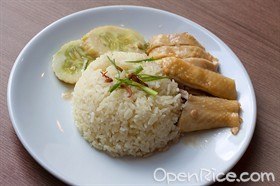 What about the flavorful liquid for poaching the bird in? Like the frugal Chinese then, the restaurant’s chef would transform otherwise dull-looking white rice into fragrant Oil Rice (油飯) by cooking it until supple and fluffy in the rich stock and drippings from the poached chicken.
What about the flavorful liquid for poaching the bird in? Like the frugal Chinese then, the restaurant’s chef would transform otherwise dull-looking white rice into fragrant Oil Rice (油飯) by cooking it until supple and fluffy in the rich stock and drippings from the poached chicken.
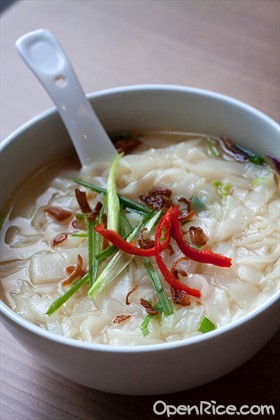 Ipoh Hor Fun (特色怡保河粉), often served in a clear, light broth, bears cultural significance. Cantonese laborers brought along their nostalgia for this flat, broad, silky, springy fresh rice noodles from the town of Shahe (廣東沙河) near Guangzhou, China. Many of them, being tin-miners, would feed their hungry souls and cure homesickness with a steaming bowl of this after work at roadside food stalls run by fellow Cantonese. They would spend the evenings catching up and reminiscing about the good old days back home. Albeit a simple dish, it reminds people of the bittersweet memories and the pining for the faraway.
Ipoh Hor Fun (特色怡保河粉), often served in a clear, light broth, bears cultural significance. Cantonese laborers brought along their nostalgia for this flat, broad, silky, springy fresh rice noodles from the town of Shahe (廣東沙河) near Guangzhou, China. Many of them, being tin-miners, would feed their hungry souls and cure homesickness with a steaming bowl of this after work at roadside food stalls run by fellow Cantonese. They would spend the evenings catching up and reminiscing about the good old days back home. Albeit a simple dish, it reminds people of the bittersweet memories and the pining for the faraway.
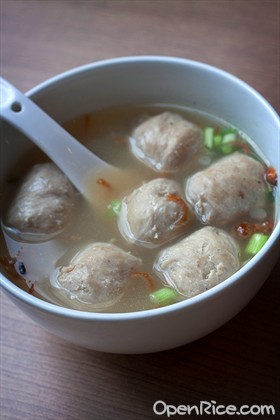 Complementary to Ipoh Hor Fun is Pork & Squid Meatballs (吊片豬肉丸), a treat prepared by Chinese parents when their children, who had left home for career opportunities elsewhere, came home for a visit. To re-create this familiar taste, the chef at Nan Yang Authentic stirs in fine strips of dried squid to a perfect blend of lean and fat meat, just like how a traditional recipe would, which not only makes springier meatballs but also adds a bolder flavor.
Complementary to Ipoh Hor Fun is Pork & Squid Meatballs (吊片豬肉丸), a treat prepared by Chinese parents when their children, who had left home for career opportunities elsewhere, came home for a visit. To re-create this familiar taste, the chef at Nan Yang Authentic stirs in fine strips of dried squid to a perfect blend of lean and fat meat, just like how a traditional recipe would, which not only makes springier meatballs but also adds a bolder flavor.
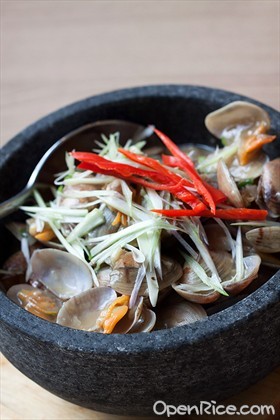 Because clams and other mollusks were the cheapest of the day’s catch, they often wound up as part of a soup on the dinner tables of fishermen’s families. One day, by some fortunate accident, a homemaker accidentally knocked over some ginger into the boiling clam broth in a wok and ended up with surprisingly fresh-tasting, gingery, oceany-sweet “Stir-Fried” Manila Clams (“la la”) in Master Stock (蒜蓉辣椒炒蜆蜆). Since then, this particular way of cooking Manila clams has gone through a wide spread within the local Chinese diaspora.
Though most of Nan Yang Authentic’s dishes are Ipoh-inspired, it also serves up Nanyang dishes from other regions, including K.L. Hokkien Mee Flash-Fried with Premium Soy Sauce (豉油皇炒福建麵), dark, glistening, unctuous, filled with wok hei; fusion delicacies such as Pattaya (Thai)-Style Tilapia (泰式芭提雅醬炸金鳳魚); Sizzling Seafood & Tamarind Teppanyaki on Banana Leaf (鐵板蕉葉阿參醬爆雙鮮); as well as Crispy, Mayo-Drizzled Sesame-Coated Deep-Fried Shrimp Salad (沙律芝麻炸脆蝦) — all of which represent the local-Chinese food scene’s ongoing evolution at the cultural crossroads known today as Southeast Asia.
Because clams and other mollusks were the cheapest of the day’s catch, they often wound up as part of a soup on the dinner tables of fishermen’s families. One day, by some fortunate accident, a homemaker accidentally knocked over some ginger into the boiling clam broth in a wok and ended up with surprisingly fresh-tasting, gingery, oceany-sweet “Stir-Fried” Manila Clams (“la la”) in Master Stock (蒜蓉辣椒炒蜆蜆). Since then, this particular way of cooking Manila clams has gone through a wide spread within the local Chinese diaspora.
Though most of Nan Yang Authentic’s dishes are Ipoh-inspired, it also serves up Nanyang dishes from other regions, including K.L. Hokkien Mee Flash-Fried with Premium Soy Sauce (豉油皇炒福建麵), dark, glistening, unctuous, filled with wok hei; fusion delicacies such as Pattaya (Thai)-Style Tilapia (泰式芭提雅醬炸金鳳魚); Sizzling Seafood & Tamarind Teppanyaki on Banana Leaf (鐵板蕉葉阿參醬爆雙鮮); as well as Crispy, Mayo-Drizzled Sesame-Coated Deep-Fried Shrimp Salad (沙律芝麻炸脆蝦) — all of which represent the local-Chinese food scene’s ongoing evolution at the cultural crossroads known today as Southeast Asia.
 Pattaya (Thai)-Style Tilapia (泰式芭提雅醬炸金鳳魚): ocean-fresh fish deep-fried until golden brown and crispy without while still tender and moist within, and served with a sweet-sour, spicy, citrusy sauce with thin shreds of tart green mango and onion.
“We are expanding our menu to serve as many Nanyang dishes as we can,” said Mr. Hee. “While we are eager to show the world what Nanyang cuisine has to offer, we feel blessed that the restaurant’s location lets us reach out to not just the locals but also tourists.”
Pattaya (Thai)-Style Tilapia (泰式芭提雅醬炸金鳳魚): ocean-fresh fish deep-fried until golden brown and crispy without while still tender and moist within, and served with a sweet-sour, spicy, citrusy sauce with thin shreds of tart green mango and onion.
“We are expanding our menu to serve as many Nanyang dishes as we can,” said Mr. Hee. “While we are eager to show the world what Nanyang cuisine has to offer, we feel blessed that the restaurant’s location lets us reach out to not just the locals but also tourists.”
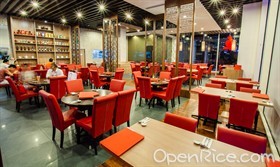 (Image by Nan Yang Authentic)
With its latest promotion, you can experience true Nanyang tastes at Nan Yang Authentic from RM10.80++ per person for its Ipoh Hor Fun with White-Cut Chicken and Pork & Squid Meatballs; RM11.80++ for White-Cut or Cantonese-Style Roast Chicken with Ipoh Bean Sprouts and Oil Rice; or RM12.80++ for Stir-Fry Special — choose one from the seven hot-off-the-wok stir-fries to go with steamed rice, nourishing Soup of the Day, and a refreshing beverage. Of course, if you crave a heartier meal, top your meal with another stir-fry for an additional RM8.
Discover more best chinese restaurant
Discover more hottest restaurant in Klang Valley
(Image by Nan Yang Authentic)
With its latest promotion, you can experience true Nanyang tastes at Nan Yang Authentic from RM10.80++ per person for its Ipoh Hor Fun with White-Cut Chicken and Pork & Squid Meatballs; RM11.80++ for White-Cut or Cantonese-Style Roast Chicken with Ipoh Bean Sprouts and Oil Rice; or RM12.80++ for Stir-Fry Special — choose one from the seven hot-off-the-wok stir-fries to go with steamed rice, nourishing Soup of the Day, and a refreshing beverage. Of course, if you crave a heartier meal, top your meal with another stir-fry for an additional RM8.
Discover more best chinese restaurant
Discover more hottest restaurant in Klang Valley